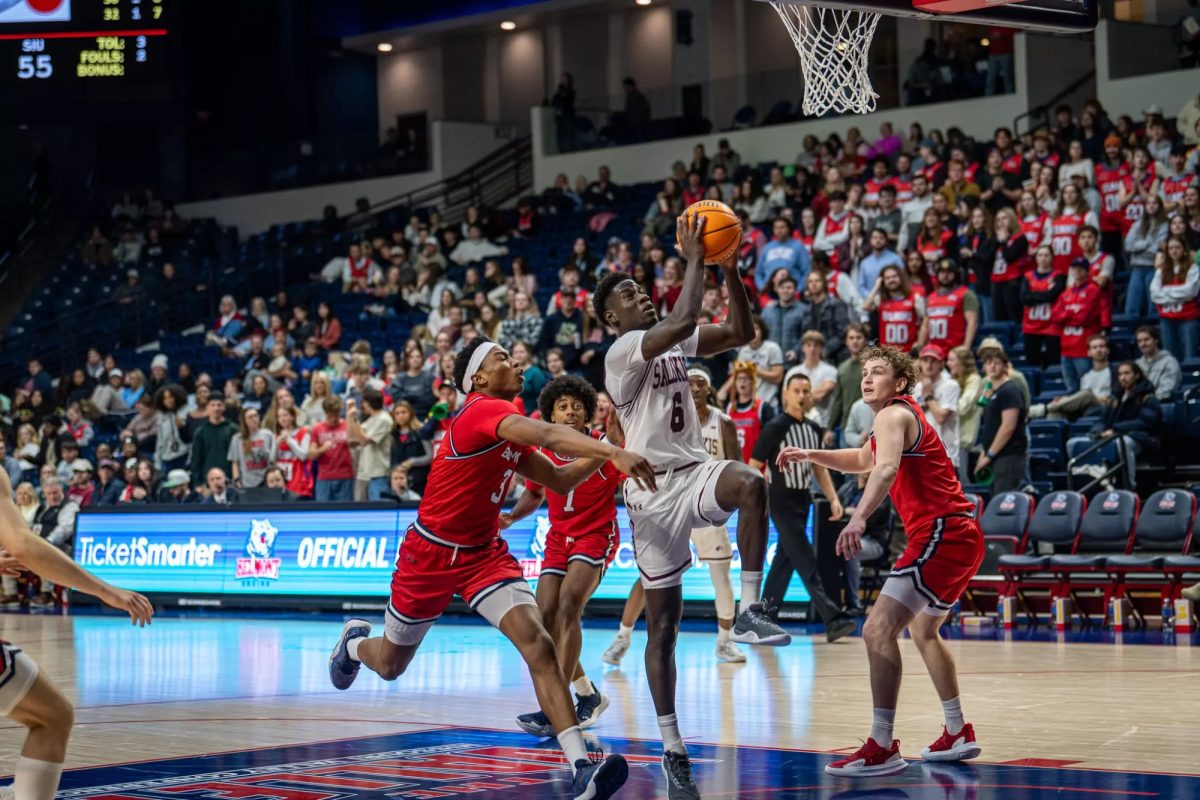The future of video games appears to be going mobile — although male players may drag their thumbs
March 29, 2016
My real-life cat, it appears, has been frustrated with me lately. Oh, she’s still spoiled, but there have been a couple of occasions in which my attention has been diverted from her to a wholly digital feline.
“Super Phantom Cat,” to be specific, has won my heart.
“Super Phantom Cat” even seems self-aware. “Love,” the game tells players, “lights up the sad and cold chamber of your heart.”
Advertisement
You know what else warms the soul? A fluffy, shape-shifting interactive cat that can jump on robots, pounce through rainbow-hued worlds and occasionally harness the power of magical sprites to blow up walls.
Plus, “Super Phantom Cat” is obedient. But like some of my other favorite recent video games, “Super Phantom Cat” is not available on the dominant form of video game consumption for the last 20-plus years, the home video game console. No, “Super Phantom Cat” is iOS-only, where its controls are simple and touch-based.
That means you can play it on your phone. Basically, it’s accessible to all, even those who insist, “Games are just not for me.” Nonsense, I say. Games are for everyone, and increasingly, that special little game for you is likely to be found in the mobile space.
And recent game data hints that the most diverse playing audience lives on mobile. Or at least the game-playing audience that is no longer traditionally male.
At this month’s Game Developers Conference in San Francisco, gaming consultancy Electronic Entertainment Design and Research presented some illuminating data. While the industry as a whole is edging closer to gender parity, game consoles and gaming computers are still predominantly used by the male gamer.
Mobile is a different story. Women make up 55 percent of mobile game players in North America. Overall, EEDAR founder Geoffrey Zatkin noted, North American gamers in 2015 leaned male 55 percent to 45 percent. But on home video game consoles, that number jumps to 60 percent male. On PCs, it’s even more heavily male at 64 percent.
It’s not that mobile games target one gender over another. It’s simply that a wider variety of game experiences seem to appeal to those who have not typically been game players.
Advertisement*
“Part of the reason for this on mobile,” Zatkin said at a conference talk, “is that mobile is … just doing a better job of marketing games that have broader appeal than handheld, console or PC.”
Certainly some of the most adventurous games of 2016 have been pocket-sized. Take the adorable, melancholic “Love You to Bits,” in which a young boy learns to live on his own after losing the love of his life, a robot female.
Or the tense minimalist action of “The Swords,” in which ink wash paintings jut out of the edges of an iPhone screen, forcing players to frantically swipe up, down, left or right. It looks as is though it should be hanging at LACMA, but its blurs of lines and splatters simulate the chaos of a sword fight. At least I think so. I’ve never been in a sword fight.
Like “Super Phantom Cat” and “Love You to Bits” before it, “The Swords” is only available for iOS. Though “Love You to Bits” is coming to other platforms this year, I’d argue it hit the most important one first.
Of course, game consoles and gaming computers are where the industry targets some of its biggest-budget games — the $100 million or so blockbusters that emphasize gunplay, such as the just-released “Tom Clancy’s The Division.”
Looking at Zatkin’s data, one could even reach the conclusion that console games are becoming almost exclusionary, focusing on core gamers — those who want expansive shoot-’em-ups and fantasy epics.
Consider them games by gamers and for gamers. Not since the Nintendo Wii has a home video game console directly gone after a non-game-playing audience.
“The Wii,” Zatkin said, “was targeted at non-core game players, who over the last generation in a lot of cases have been migrating off of console and onto Web, social and mobile discretions.”
Me? I’m tired of guns. I want a phantom cat or some abstract swordplay. So it was distressing when Zatkin noted that just a small portion of the current generation of console titles has generated — by far — the lion’s share of retail revenue in North America since 2012. Get ready, perhaps, for more games that look the same.
“Another trend: We’re seeing the console shift from a balanced portfolio of games,” Zatkin said, “from both core and casual gaming, to a core-focused portfolio.”
The word “core” essentially means those focused on the hardcore gaming audience.
In 2007, for instance, top-selling genres such as shooters and action-adventure games accounted for 44 percent of the retail revenue for consoles. In 2014, they made up 61 percent. No wonder the market is constantly flush with games that encourage players to pull a trigger. It’s the safest bet.
And that’s a problem, especially when it comes to expanding the gaming audience. I long for a day when games are as vital a part of the morning conversation as an episode of “House of Cards,” “Master of None” or “Orphan Black.” That won’t happen unless the industry’s most powerful publishers look beyond the current established audience.
With fewer top-flight games made per year, the ones that do make it to market risk catering to a known audience rather than winning over a new one. If you’re turned off by guns and a complex control scheme, it’s easy to write off “The Division,” “Fallout 4,” a “Call of Duty Game” or “Star Wars: Battlefront” as simply not for you.
This isn’t to say there aren’t great games released on consoles.
I’m excited, for instance, for Naughty Dog’s “Uncharted 4,” as I do love me a big blockbuster. And the Santa Monica studio has shown an ability to craft well-paced stories. Additionally, my two favorite games of 2016 have homes on consoles — Night School’s teen thriller, “Oxenfree,” and Campo Santo’s spooky tale of loneliness, “Firewatch.”
But these latter two are titles that come from the still-burgeoning and typically risk-taking independent game sector. They’re also available on PCs. They’re games you should play, but I’m not so sure they’re going to move consoles.
On the flip side, mobile game stores can be overwhelming. Last year alone, Zatkin said, there were more than 100,000 iOS games released in North America. Whew. It takes work then to find the one about boy who is lovesick over a lost robot.
But it exists. And games like it exist, and not because one platform caters to men and another caters to women.
These games exist because, once again, there’s a platform that believes games belong to everyone.
New Mobile Video Games That Will Keep you Going
There are a lot of mobile games out there — last year more than 100,000 iOS games were released in North America. Here are a few recent mobile games worthy of exploration:
— “Love You to Bits.” Alike/Pati. Breakups stink. They’re worse when your girlfriend is scattered around the galaxy. In this iOS game a young boy tries to put back together his first love, a female robot, and learns to live on his own along the way.
— “Story Warriors: Fairy Tales.” Below the Game. Tales such as “Snow White,” “Little Red Riding Hood,” “Cinderella” and more get remixed in this text-driven puzzler about a young woman who gets trapped in folklore. Tap on words to bring them to life, and piece together nouns and adjectives as if they’re math problems, the right solution inspiring a cutesy animated sequence.
— “SPL-T” Simogo. Swedish studio Simogo is one of the most adventurous companies out there, specializing in head-scratching, text-heavy games such as “Device 6” and “The Sailor’s Dream.” “SPL-T” is a back-to-basics puzzle game. In the black and white game, players place a horizontal line and then a vertical one, trying to create as many splits as possible.
— “Super Phantom Cat.” Veewo. Cats! Robots! “Super Phantom Cat” takes the weirdness of “Super Mario Bros.,” gives it a zany feline-meets-sci-fi makeover, and uses slick touch controls to create a freshly retro experience. It’s all delivered with a gooey feel-good message and some rainbow-hued prettiness.
— “The Swords.” Sunhead Games. Imagine a scene in an action movie, one in which one swordsman is surrounded by an army on all sides. Now imagine all the action is presented in a minimal ink wash art style. By zeroing in on the blades, “The Swords” emphasizes the chaos of battle. Swipe fast, and do so with precision.
___
(c)2016 Los Angeles Times
Visit the Los Angeles Times at www.latimes.com
Distributed by Tribune Content Agency, LLC.
Advertisement







